Razer Phone 2 Review: A Good Gaming Phone Looking to Break Out
The Razer Phone 2 offers good performance, excellent audio and a 120-Hz display, but the phone's camera still needs work.
Why you can trust Tom's Guide
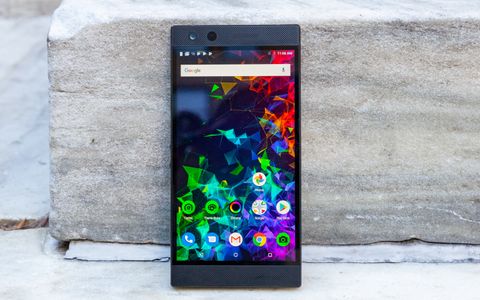
Editors’ Note: Shortly before publication, Razer released a software update that’s designed to improve camera quality, audio performance and display tuning. We will update this review once we’ve evaluated this update.
When Razer debuted the original Razer Phone, the gaming specialist focused on creating a phone for mobile gamers, largely succeeding. Razer's original phone was the first to feature a smartphone display with a 120-Hertz refresh rate and audio that sounded better than that from most laptops. True, there were some bugs to work out, but it was an admirable first effort.
Razer's back with the second-gen version of its phone, which is flashier, prettier and more durable than the original. Priced at $799, the Razer Phone 2 keeps the audio and that incredible refresh rate of its predecessor, but it also seeks to improve on the things that kept that phone from the top of heap, and those efforts meet with varying degrees of success. Unfortunately, lackluster cameras and a display dimmer than the competition's are stones around the neck of an otherwise-solid smartphone.
Design
When I hear the words "gaming phone," visions of aggressive, outlandish design created from discarded parts of an errant gaming laptop or desktop enter my mind's eye. The second iteration of the Razer Phone is none of those things. Instead, it's a master class in sophisticated elegance, much like its predecessor, but with a few notable changes.
For starters, the rear panel is made of shiny Corning Gorilla Glass 5. It's striking, but nowhere near as striking as the new logo. Going full-on gamer, Razer's three-headed-snake emblem now glows with the enticing glimmer of Chroma lighting. And just like on any Razer product worth its salt, the color and effects can be controlled via Razer's preloaded software. Once you've had your fill of gazing at all the pretty colors, hazard a gander at the logo and check out the pair of 12-megapixel cameras sandwiching the LED flash as they gently jut outward.
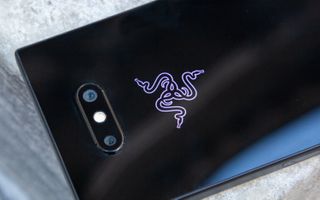
If you're not a fan of the high-gloss look, don't worry; you can also get the new phone with a satin finish on the rear panel, something we've yet to see on a smartphone. That version adds another $100 to the price, though.
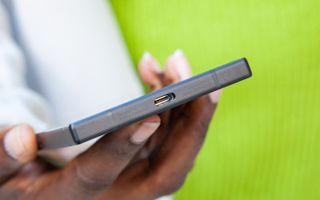
Both the sides of the Razer Phone 2 and the front-mounted speaker grilles are constructed from the black CNC aluminum I've come to know and love from Razer. You'll find a microSD/SIM card slot on the top left corner, above the two raised, circular volume buttons. There's an elongated, slightly recessed oval on the right for the power button. A lone USB Type-C port sits at the bottom, meaning you're going to need a dongle or a pair of wireless headphones.
At the front of the Razer Phone 2 are two speakers, one at the top and one at the bottom of the 5.72-inch screen. An 8-MP shooter is nestled in the top left of the top speaker, along with a flash.
MORE: The Best Phones for Gaming
All that glass and aluminum make the Razer Phone 2 (6.2 x 3.1 x 0.3 inches) a heavyweight, at 7.8 ounces. The iPhone XS Max (6.2 x 3.1 x 0.3 inches) and Samsung Galaxy Note 9 (6.3 x 3 x 0.34 inches) are a tad lighter, at 7.3 and 7.1 ounces. The Google Pixel 3 XL (6.2 x 3.0 x 0.3 inches) is the lightest, at 6.9 ounces.
Durability
Despite all the glass on the Razer Phone 2, it's a surprisingly durable phone. Both the front and back panels consist of Corning Gorilla Glass 5, while the actual frame is aluminum.

In an unexpected twist, the phone has an IP67 rating, meaning it can stand to be submerged in up to 5 feet of water for half an hour, despite all those holes in the speaker grille. That doesn't mean that you can start gaming underwater, but you can breathe a sigh of relief when your expensive piece of tech takes that inevitable dive into the toilet.
A Mobile Light Show
Thanks to its resplendent Chroma lighting, Razer could have settled for making a phone with the prettiest light show. I mean, it's easy to get caught up in finding that perfect shade out of the 16.8 million hues available for the logo to flash in the preinstalled Chroma app. I took the easy way out and chose Spectrum, so the emblem could paint with all the colors of the wind. In addition to the color(s), you can also select the LED brightness and one of three effects. (Static, which is one constant color; the pulsating Breathing effect; and Spectrum, which cycles through every color.)

But aside from all that captivating color, the best thing about the Chroma app is that you can set the lighting to glow in different colors based on your notifications. Colors are tied to the logo of apps, so your phone's logo glows blue when a Microsoft Outlook message arrives, red for Google Chrome, purple for Microsoft Teams and so on.
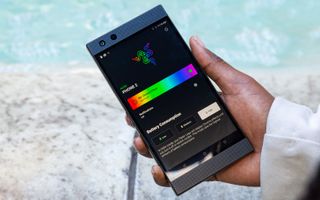
Aware that all this flash could negatively affect the battery, Razer added battery-consumption settings. On High, the Chroma effects will flash until you turn the phone off or change modes. Medium tones it down a bit, using Chroma only when the screen is on and for notifications. With the lowest setting activated, you'll see the lighting only if you have Notifications toggled on.
Display
The more things change, the more they stay the same. Razer kept the 2560 x 1440, 120-Hertz UltraMotion LCD IGZO display from the original Razer Phone. This is the same display that earned Netflix certification.

Last year, the panel impressed with its buttery-smooth graphic-rendering capabilities, while this time around, it's just a smidge bigger, at 5.72-inches. Just like Nvidia's G-Sync technology, UltraMotion syncs up the display's refresh rate to the GPU, giving you those lovely graphics. However, those tear-free images come at a cost. When it comes to colors and brightness, the LCD panel on the Razer Phone 2 simply can't hold a candle to Super AMOLED displays on phones like the Note 9 .
I watched the If Beale Street Could Talk trailer with a few of my colleagues, and we were astounded at how dim and dull the Razer Phone 2 looked next to the Note 9. The light blue shower tiles looked dingy on the Razer Phone's screen, as did the marigold curtain as we watched two adorable kids splash in their bubble bath. It wasn't so bad when were looking at the phones dead on, but the minute we moved from the sweet spot, color on the Razer Phone 2 washed out, signaling rather narrow viewing angles. At least, details were sharp enough that I could see individual bubbles in the suds on one of the children's heads.

Although not as vibrant as on the competition, the colors on the Razer Phone 2 as I played Real Racing 3 were fairly rich. I could see the sun glinting off my neon-green Ford Focus as I jockeyed for position on the track.
When we measured the Razer Phone 2's color-reproduction capabilities, we found that the panel could reproduce 104 percent of the sRGB gamut. That's good, but the iPhone XS Max did better, with 123 percent. The Note 9 more than doubled the Razer's score, at 224 percent.
With this phone's color-accuracy score of 1.2 on Delta-E (0 is ideal), it was easy to see why the colors on the Razer Phone 2 seemed so dull. The Note 9 and XS Max were much more accurate, with scores of 0.3 and 0.2, respectively.
MORE: Razer Phone 2 Hands-On: A Better Gaming Phone, But Should You ...
Razer also struck out on the brightness test, averaging 492 nits, which is much dimmer than the results from the XS (606 nits), Max and Note 9 (604 nits), though it's above the average brightness for smartphones (488 nits).
Audio: Still the king
Once again, Razer rules the roost as the king of smartphone audio. The front-firing speakers pack a serious wallop, easily filling our test lab with loud, clean sound. Using a combination of Dolby Atmos software and Razer's proprietary algorithms, the phone delivered a warm, relatively balanced reproduction of Rihanna's "Work." However, like with most smartphones, the bass continues to be a key missing element.

That didn't stop the phone from delivering some rather realistic car audio as I tore down the track in Real Racing 3. And when I blew up an explosive barrel in Shadowgun Legends, the sound had discernable depth.
MORE: Best Gaming Headsets - Picks for PCs, PS4, Xbox and ...
Although the Dolby Atmos software gives you four options to choose from (Dynamic, Movies, Music and Custom), my default quickly became Music even when gaming, as it gave the fullest performance with the most clarity.
Cameras: Back to the drawing board
When I talked to Razer about its latest phone, the company vowed major improvements to the lackluster camera from the OG Razer Phone. The biggest change involves adding Sony IMX sensors to the Razer Phone 2. While both rear lenses on the new phone are 12 megapixels, one is a wide-angle lens and offers optical image stabilization, while the other is a telephoto lens with a 2x zoom.

Another notable change relates to the actual camera software; there are actually some bells and whistles — not many but some, like a Beauty and Portrait mode. However, the app still lacks a Pro mode, so anyone looking to adjust white balance or ISO is out of luck.
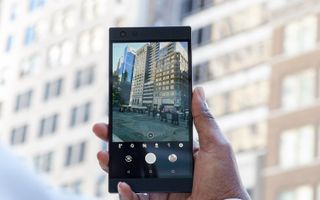
Alas, the more things change, the more they stay the same. I took several test shots with the Razer Phone 2 and the Note 9, and it's clear that Razer has a lot more work to do in the camera department.
MORE: Camera Face-Off: Can an iPhone Beat a DSLR?
A shot taken in our video studio yielded muted color, making Cappy (a key character in Super Mario Odyssey) look dull and drab. Compare that to the Note 9, which portrayed Cappy in a beautiful cherry red. The devil, and Razer, showed up in the details, providing more definition in the brick face background.
The Razer Phone had a better showing when I ventured outside, serving a fair amount of detail, particularly in the delicate veins of the pink petals in a flower. However, the edges of the picture were rather fuzzy, which was disappointing. The image taken by the Note 9 was a bit dark but still had the more-vibrant color.
One place the original Razer Phone cameras struggled was capturing shots in low light, and I'm happy to report some improvement with the Razer Phone 2. It captured the shot almost instantaneously, instead of making me wait 2 to 3 seconds. And the new Razer Phone definitely grabs more detail than its predecessor did. However, it took only one zoom in to reveal a host of digital noise in the Razer Phone's shot, and my subject's beard look like the metal shavings in one of those old-school magnetic-beard toys. The Note 9's pic had much better skin tone and detail.
The Razer's 8-MP front camera is passable but needs improvement. It washed out my skin tone, giving me an ashy appearance. The window in the background was also blown out, which only made the rest of the picture look worse.
Performance
Armed with a 2.8-GHz Qualcomm Snapdragon 845 processor with 8GB of RAM and 64GB of onboard storage, the Razer Phone 2 is not here to play. (Well, it is, but just not like that.) The 845 is the most powerful Snapdragon CPU on the market, and its presence here only solidifies Razer's intent to deliver a kick-ass gaming experience in the company's flagship. Navigating between homepages and apps was quick and seamless, even after I opened 20 tabs in Google Chrome and launched several games.

The phone held its own against most of the competition during our synthetic testing, scoring 8,903 on Geekbench 4, which measures overall performance. That score beat the showing by the Pixel 3 XL (7,684), which has its own 845 CPU, but the Razer couldn't top the XS Max and its A12 Bionic CPU, which shattered the curve, at 11,515.
It took the new Razer Phone 3 minutes and 59 seconds to transcode a 4K video clip to 1080. This is a passable time, but nowhere near as fast as the times of 2:42 and 0:39 from the Pixel 3 XL and XS Max, respectively.
And while multitasking and switching between apps quickly is important on a smartphone, the Razer Phone isn't just a smartphone. It's also a gaming phone, so it had better deliver on its biggest claim. Thankfully, the phone's Adreno 630 GPU lived up to the hype, scoring 4,621 on the 3DMark Slingshot Extreme 3.1 benchmark. That mark easily passed the respective 4,396 and 4,339 scores put up by the Pixel 3 XL and the XS Max. However, the Note 9 had a slightly better score of 4,639.
In case you need more than 64GB for storage, you can expand the Razer Phone 2's capacity via the microSD slot which supports up to 2TB.
Gaming Du Jour
Gaming on the Razer Phone 2 is just as fun as it was on Razer's original. The UltraMotion tech and the high refresh rate meant that when I ran into a swarm of hostile aliens in Shadowgun Legends, there was never any slowdown. Instead, I blasted my way through the horde with relative ease, as guts and empty casings flew everywhere. The powerful, front-firing speakers bombarded my ears with big explosions, gritty battle and death cries, and the staccato beat of persistent gunfire.
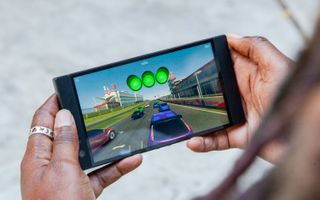
While I'm a huge fan of the Chroma app, when it's time to game, I'm all about Cortex. This handy app from Razer acts as a game aggregator, optimizer and recommendation resource.
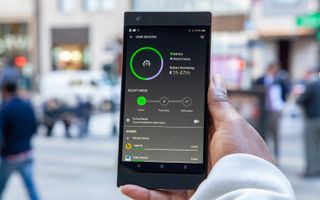
Once launched, Cortex is broken down into three segments. The Featured section shows you all the games that are optimized to run with the Razer Phone's gaming-centric specs. Library displays all the games currently installed on the device. You also have the option to go through your app library in case Cortex missed something or if you'd like to disable access.
MORE: Nintendo Switch vs. PS4 vs. Xbox One: Which Console Should You Get?
Then there's Game Booster, where the magic happens. Not only can you toggle the overall app based on power-conservation settings (Custom, Power Saver and Performance), but you can also enable the Do Not Disturb feature, so you can play without the distraction of pesky notifications. You also have the ability to edit Booster configurations for every game in your library via slider. Starting from More Battery and ending at Higher Performance, the CPU clock speed, resolution and display refresh rate adjust accordingly, so you can get the best out of your gaming experience whether you're playing on a full battery or with a quarter left in the tank.
Battery Life
We're still working to get our Tom's Guide Battery Test running on the Razer Phone 2, in which we have the phone surf the web continuously over T-Mobile's LTE network until the device runs out of juice. Please stay tuned for updated results.
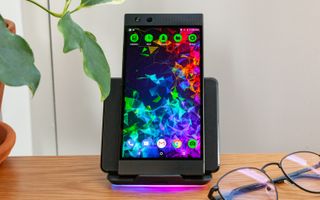
I had a week to live, work and play with the Razer Phone 2, and over that time, I managed to squeeze about 6 hours of mixed usage on average per day out of the phone's 4,000-mAH battery. That means that in the moments I wasn't fighting dinosaurs in Ark: Survival Evolved or repelling hostile forces in Shadowgun Legends or Vainglory, I was taking advantage of the Netflix-certified display and the THX-certified audio by watching Big Mouth and The Dragon Prince on Netflix.
When gaming, I set the Game Booster to Higher Performance, which pushed the CPU clock speed to 2.8 GHz and the panel refresh rate to 120 Hz. For everything else, I used the Optimal setting, which dropped the speed to 2.32 GHz and the refresh rate to 90 Hz. I spent 2 hours gaming per day and about an hour watching Netflix; I spent the rest of the time checking social media and reading news. I never got the phone to last a full workday; the closest I got was 7 hours and 15 minutes when I cut down on the gaming.
Waiting for your phone to charge can be a drag, especially when you're anxious to get to the next level of your game. To alleviate this burden, the Razer Phone 2 has Qualcomm's QuickCharge4+ technology, which the company claims can restore a 50 percent charge in only 15 minutes.
Unlike the previous model, the Razer Phone 2 supports wireless charging, which Razer made sure to play up with its new $99 wireless charger. Decked out with Chroma lighting, this charger gives you a light show, even when your phone is out of commission.
Software
Just because I own a Samsung phone, that doesn't mean I can't appreciate vanilla Android. Running on stock Android 8.1 (Oreo), the Razer Phone 2's user interface is clean, minimal and easy to navigate. Also, unfettered by the likes of TouchWiz or any other underlying skin, app navigation and phone operation overall seem much more fluid.
I'm a fan of the long-press app shortcuts and notifications dots on Razer’s phones, which make everything faster and more convenient. Razer did make a few minor aesthetic alterations to the OS, such as changing the text color in the notifications from white to Razer's emerald green.
Accessories
While Razer's new wireless charger is nice, it doesn't do much to enhance the mobile gaming experience. But the company does have a few peripherals that do, such as the $149.99 Raiju Mobile controller, which features an adjustable phone mount, mappable multifunction buttons and a hair-trigger mode.
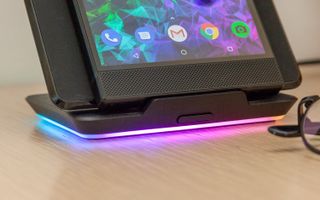
You can also buy the $99 Razer Hammerhead USB-C ANC headphones, a pair of in-ear buds that offer a built-in digital-to-audio converter, active noise cancellation, in-line controls and an integrated microphone.
Configurations
Although Razer is offering two versions of the Razer Phone 2, the only difference is the look. The glossy mirror finish costs $799, while the satin finish is $899. Both phones will still have the same internals: a 2.8-GHz Qualcomm Snapdragon 845 processor with 8GB of RAM, 64GB of storage and an Adreno 630 GPU.
Bottom Line
I like the idea of Razer Phone 2 becoming a true flagship phone that happens to excel at gaming, but I'm still on the fence about the concept of gaming phones — at least in the United States. Mobile gaming has a major following in Asia, thanks to games like Arena of Valor, while most U.S. Android gamers are waiting for access to Fortnite.
Razer's second bite at the apple offers a flashier, yet still-elegant aesthetic that's balls-to-the-walls Razer, with good performance and that best-in-class audio. And at a starting price of $799, the Razer Phone 2 is rather inexpensive in an era when $1,000 phones are becoming the norm. That 120-Hz display really does make games look better than on your average smartphone, too.
However, Razer still has a ways to go before its phone can be considered a flagship device. While there were some improvements on the Razer Phone 2's camera, it's not enough to compete with heavy hitters like the Samsung Galaxy Note 9.
Speaking of Samsung, while I understand why it's important for Razer to have the 120-Hz LCD display, the company has to find a way to compete with AMOLED panels. Overall, the Razer Phone 2 is a good choice for gamers and multimedia lovers who want the best audio and graphics rendering, but Razer still has some more retooling to do if its phone is going to break out of its gaming niche.
Credit: Tom's Guide
Sign up to get the BEST of Tom's Guide direct to your inbox.
Here at Tom’s Guide our expert editors are committed to bringing you the best news, reviews and guides to help you stay informed and ahead of the curve!
Sherri L. Smith has been cranking out product reviews for Laptopmag.com since 2011. In that time, she's reviewed more than her share of laptops, tablets, smartphones and everything in between. The resident gamer and audio junkie, Sherri was previously a managing editor for Black Web 2.0 and contributed to BET.Com and Popgadget.
